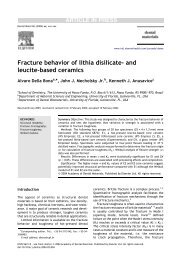Microleakage of various cementing agents for full cast crowns
Microleakage of various cementing agents for full cast crowns
Microleakage of various cementing agents for full cast crowns
Create successful ePaper yourself
Turn your PDF publications into a flip-book with our unique Google optimized e-Paper software.
452<br />
marginal gap size <strong>of</strong> 120 mm (as defined by Mc Lean<br />
and Von Frauenh<strong>of</strong>er [40]) in all test groups. As in<br />
our own study, White et al. [9] did not find any<br />
correlation between marginal gaps and microleakage.<br />
Their study examined <strong>full</strong> <strong>cast</strong> <strong>crowns</strong> made <strong>of</strong><br />
a non-precious alloy that had been cemented with a<br />
zinc-phosphate cement (Flecks; Mizzy, Cherry Hill,<br />
NJ, USA), a polycarboxylate cement (Durelon; 3M<br />
ESPE, Seefeld, Germany), a glass–ionomer cement<br />
(Ketac-Cem; 3M ESPE, Seefeld, Germany), a micr<strong>of</strong>illed<br />
resin with dentin bonding (Thin Film Cement<br />
and Tenure; Den Mat Corp., Santa Maria, CA, USA),<br />
and a resin cement (Panavia Ex; Kuraray, Osaka,<br />
Japan). Nor did the study <strong>of</strong> Lindquist and Connolly<br />
[10] find any correlation between microleakage and<br />
marginal gap when using a zinc-phosphate cement<br />
(Flecks; Mizzy, Cherry Hill, NJ, USA) and a resinmodified<br />
glass–ionomer cement (Vitremer (now<br />
RelyX Luting); 3M ESPE, Seefeld, Germany). However,<br />
more research is needed to determine the<br />
relationships between restoration-associated diseases<br />
and the variables <strong>of</strong> microleakage, marginal<br />
opening, and host factors.<br />
Although we used established protocols to<br />
simulate the oral environment, the real-life<br />
scenario is too complex to be <strong>full</strong>y reproduced<br />
by experimental set-ups <strong>of</strong> this type. On balance,<br />
it is reasonable to assume that the data obtained<br />
in the <strong>various</strong> study groups constituted a viable<br />
basis <strong>for</strong> comparison. In clinical practice, however,<br />
additional factors such as biocompatibility,<br />
thermal/electric conductivity, ease <strong>of</strong> use, and,<br />
most important, the specific requirements <strong>of</strong> each<br />
case (e.g. height <strong>of</strong> the residual tooth structure<br />
and preparation angle) must enter the equation to<br />
find out which <strong>cementing</strong> agent is most<br />
appropriate.<br />
Conclusions<br />
1. None <strong>of</strong> the <strong>cementing</strong> <strong>agents</strong> investigated in<br />
this study yielded a perfect seal at the bonding<br />
interface in enamel or dentin.<br />
2. All <strong>cementing</strong> <strong>agents</strong> investigated were associated<br />
with higher degrees <strong>of</strong> microleakage when<br />
the tooth substrate was located in dentin.<br />
3. The self-adhesive universal resin cement (RelyX<br />
Unicem) revealed the smallest degree <strong>of</strong> microleakage<br />
both in enamel and in dentin.<br />
4. After artificial aging differences in the marginal<br />
gap quality were observed.<br />
5. An association between marginal gap and microleakage<br />
was not observed.<br />
References<br />
A. Piwowarczyk et al.<br />
[1] Crim GA, Chapman KW. Reducing microleakage in class II<br />
restorations: an in vitro study. Quintessence Int 1994;25:<br />
781–5.<br />
[2] Bergenholtz G, Cox CF, Loesche WJ, Syed SA. Bacterial<br />
leakage around dental restorations: its effect on the dental<br />
pulp. J Oral Pathol 1982;11:439–50.<br />
[3] Cox CF, Keall CL, Keall HJ, Ostro E, Bergenholtz G.<br />
Biocompatibility <strong>of</strong> surface-sealed dental materials against<br />
exposed pulps. J Prosthet Dent 1987;57:1–8.<br />
[4] Going RE, Sawinski VJ. <strong>Microleakage</strong> <strong>of</strong> a new restorative<br />
material. J Am Dent Assoc 1966;73:107–15.<br />
[5] Mjör IA, Moorhead JE, Dahl JE. Reasons <strong>for</strong> replacement <strong>of</strong><br />
restorations in permanent teeth in general dental practice.<br />
Int Dent J 2000;50:362–6.<br />
[6] Tjan AH, Dunn JR, Grant BE. Marginal leakage <strong>of</strong> <strong>cast</strong> gold<br />
<strong>crowns</strong> luted with an adhesive resin cement. J Prosthet<br />
Dent 1992;67:11–15.<br />
[7] Tjan AH, Peach KD, VanDenburgh SL, Zbaraschuk ER.<br />
<strong>Microleakage</strong> <strong>of</strong> <strong>crowns</strong> cemented with glass–ionomer<br />
cement: effects <strong>of</strong> preparation finish and conditioning<br />
with polyacrylic acid. J Prosthet Dent 1991;66:602–6.<br />
[8] White SN, Yu Z, Kipnis V. The effect <strong>of</strong> seating <strong>for</strong>ce on film<br />
thickness <strong>of</strong> new adhesive luting <strong>agents</strong>. J Prosthet Dent<br />
1992;68:476–81.<br />
[9] White SN, Ingles S, Kipnis V. Influence <strong>of</strong> marginal opening<br />
on microleakage <strong>of</strong> cemented artificial <strong>crowns</strong>. J Prosthet<br />
Dent 1994;71:257–64.<br />
[10] Lindquist TJ, Connolly J. In vitro microleakage <strong>of</strong> <strong>cementing</strong><br />
<strong>agents</strong> and crown foundation material. J Prosthet Dent<br />
2001;85:292–8.<br />
[11] Piwowarczyk A, Lauer HC. Mechanical properties <strong>of</strong> luting<br />
cements after water storage. Oper Dent 2003;28:535–42.<br />
[12] Li ZC, White SN. Mechanical properties <strong>of</strong> dental luting<br />
cements. J Prosthet Dent 1999;81:597–609.<br />
[13] Nakabayashi N, Kojima K, Masuhara E. The promotion <strong>of</strong><br />
adhesion by the infiltration <strong>of</strong> monomers into tooth<br />
substrates. J Biomed Mater Res 1982;16:265–73.<br />
[14] Raskin A, D’Hoore W, Gonthier S, Degrange M, Dejou J.<br />
Reliability <strong>of</strong> in vitro microleakage tests: a literature<br />
review. J Adhes Dent 2001;3:295–308.<br />
[15] Jorgensen KD. Factors affecting the film thickness <strong>of</strong> zincphosphate<br />
cements. Acta Odontol Scand 1960;18:479–90.<br />
[16] Wu W, Cobb EN. A silver staining technique <strong>for</strong> investigating<br />
wear <strong>of</strong> restorative dental composites. J Biomed Mater Res<br />
1981;15:343–8.<br />
[17] White SN, Sorensen JA, Kang SK, Caputo AA. <strong>Microleakage</strong><br />
<strong>of</strong> new crown and fixed partial denture luting <strong>agents</strong>.<br />
J Prosthet Dent 1992;67:156–61.<br />
[18] Holmes JR, Bayne SC, Holland GA, Sulik WD. Considerations<br />
in measurement <strong>of</strong> marginal fit. J Prosthet Dent 1989;62:<br />
405–8.<br />
[19] Shortall AC, Fayyad MA, Williams JD. Marginal seal <strong>of</strong><br />
injection-molded ceramic <strong>crowns</strong> cemented with three<br />
adhesive systems. J Prosthet Dent 1989;61:24–7.<br />
[20] Feilzer AJ, De Gee AJ, Davidson CL. Curing contraction <strong>of</strong><br />
composites and glass–ionomer-cements. J Prosthet Dent<br />
1988;59:297–300.<br />
[21] Inokoshi S, Willems G, Van Meerbeek B, Lambrechts P,<br />
Braem M, Vanherle G. Dual-cure luting composites. Part I:<br />
filler particle distribution. J Oral Rehabil 1993;20:133–46.<br />
[22] Crim GA, Garcia-Godoy F. <strong>Microleakage</strong>: the effect <strong>of</strong><br />
storage and cycling duration. J Prosthet Dent 1987;57:<br />
574–6.
















